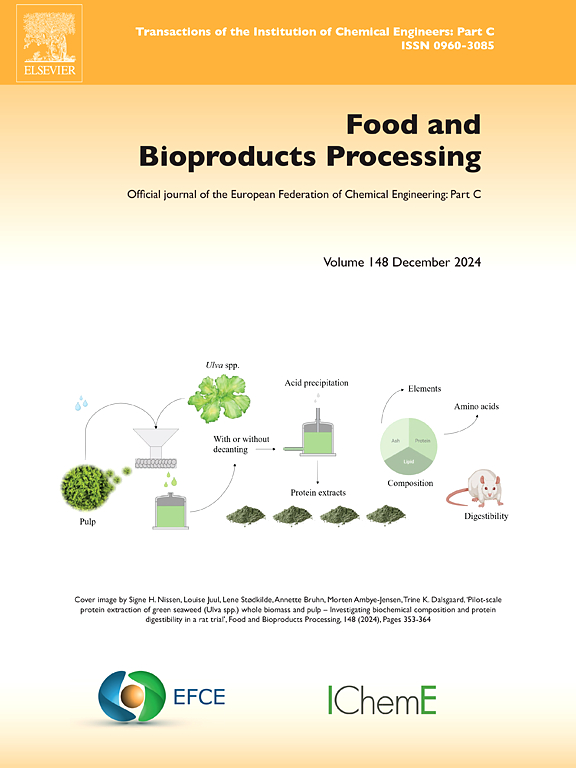姜黄芳香叶生物基产品
IF 3.4
2区 农林科学
Q2 BIOTECHNOLOGY & APPLIED MICROBIOLOGY
引用次数: 0
摘要
最大限度地利用自然资源,从而尽量减少使用不可生物降解的合成聚合物,是促进循环经济和实现可持续发展目标的主要努力。姜黄是一种主要的商业作物,主要用于种植其根或根茎。然而,每英亩大约产生30-40 吨姜黄叶,通常作为废物处理,燃烧或掩埋。姜黄叶是不可避免的,是可再生的、可持续的、可生物降解的、低成本的生物制品开发资源。此外,姜黄叶还具有固有的香味和其他独特的特性,可以用来开发可生物降解和一次性的生物制品。在本研究中,姜黄叶作为聚丙烯(PP)的增强材料,通过压缩成型制备生物基复合材料。研制了含有高达90% %姜黄叶的复合材料,并对其形貌、力学性能、阻燃性、吸声性、吸水性和热性能进行了研究。此外,生物复合材料被制成一次性风扇叶片。含有60% %粉末姜黄叶的复合材料的拉伸和弯曲性能相对高于其他比例的复合材料。加入相容剂(马来化聚丙烯)后,拉伸强度提高到8.5 MPa,弯曲强度提高到14.5 MPa。该复合材料的吸声系数高达~ 0.36,导热系数在0.402-0.317 W/mK范围内,阻燃等级为V1, LOI为24,适用于大多数应用。生物基产品,如风扇叶片可以制造和复合材料可用于各种高价值的应用。姜黄叶的增值将有助于使姜黄在食品和非食品应用中更加经济和负担得起。本文章由计算机程序翻译,如有差异,请以英文原文为准。
Biobased products from aromatic Curcuma longa L. leaves
Maximizing the use of natural resources and consequently minimizing the use of non-biodegradable synthetic polymers are major efforts towards promoting circular economy and achieving sustainable development goals. Turmeric is a major commercial crop and is mainly grown for the root or rhizome. However, about 30–40 tons of turmeric leaves are generated per acre and are generally disposed as waste and are burnt or buried. Turmeric leaves are inevitably generated and are renewable, sustainable, biodegradable and low cost sources for developing bioproducts. In addition, turmeric leaves also have inherent fragrance and other unique properties that can be utilized to develop biodegradable and disposable bioproducts. In this research, turmeric leaves were used as a reinforcement for polypropylene (PP) to fabricate bio-based composites by compression molding. Composites with up to 90 % turmeric leaves were developed, and the morphology, mechanical properties, flame-resistance, sound absorption, water absorption, and thermal properties were studied. Further, the biocomposites were fabricated into disposable fan blades. The tensile and flexural properties of the composites containing 60 % powdered turmeric leaf were comparatively higher than those of other ratios. Addition of a compatibilizer (maleated polypropylene) enhanced the tensile strength to 8.5 MPa and flexural strength to 14.5 MPa. The composite had sound absorption coefficient up to ∼0.36, thermal conductivity in the range of 0.402–0.317 W/mK, and flame resistance rating of V1 and LOI of 24, acceptable for most applications. Biobased products such as fan blade could be fabricated and the composites could be used for various high value applications. Valorization of turmeric leaves will assist in making turmeric more economical and affordable for food and non-food applications.
求助全文
通过发布文献求助,成功后即可免费获取论文全文。
去求助
来源期刊

Food and Bioproducts Processing
工程技术-工程:化工
CiteScore
9.70
自引率
4.30%
发文量
115
审稿时长
24 days
期刊介绍:
Official Journal of the European Federation of Chemical Engineering:
Part C
FBP aims to be the principal international journal for publication of high quality, original papers in the branches of engineering and science dedicated to the safe processing of biological products. It is the only journal to exploit the synergy between biotechnology, bioprocessing and food engineering.
Papers showing how research results can be used in engineering design, and accounts of experimental or theoretical research work bringing new perspectives to established principles, highlighting unsolved problems or indicating directions for future research, are particularly welcome. Contributions that deal with new developments in equipment or processes and that can be given quantitative expression are encouraged. The journal is especially interested in papers that extend the boundaries of food and bioproducts processing.
The journal has a strong emphasis on the interface between engineering and food or bioproducts. Papers that are not likely to be published are those:
• Primarily concerned with food formulation
• That use experimental design techniques to obtain response surfaces but gain little insight from them
• That are empirical and ignore established mechanistic models, e.g., empirical drying curves
• That are primarily concerned about sensory evaluation and colour
• Concern the extraction, encapsulation and/or antioxidant activity of a specific biological material without providing insight that could be applied to a similar but different material,
• Containing only chemical analyses of biological materials.
 求助内容:
求助内容: 应助结果提醒方式:
应助结果提醒方式:


